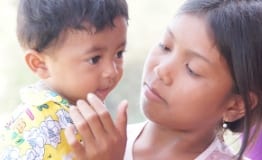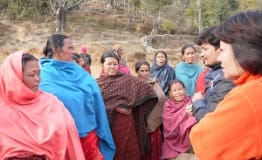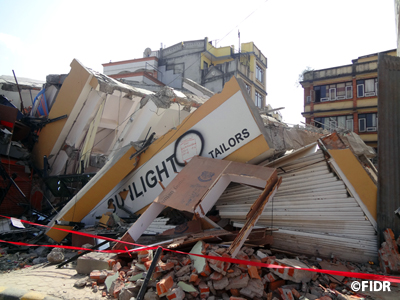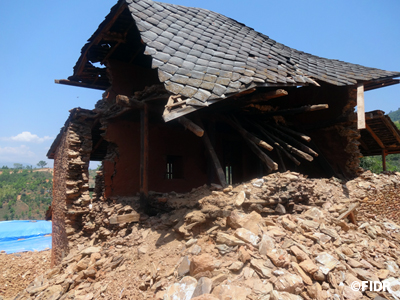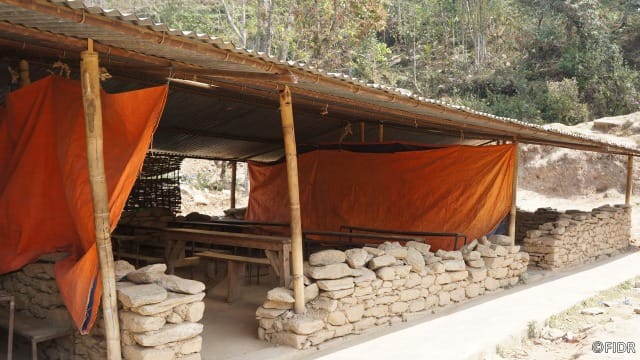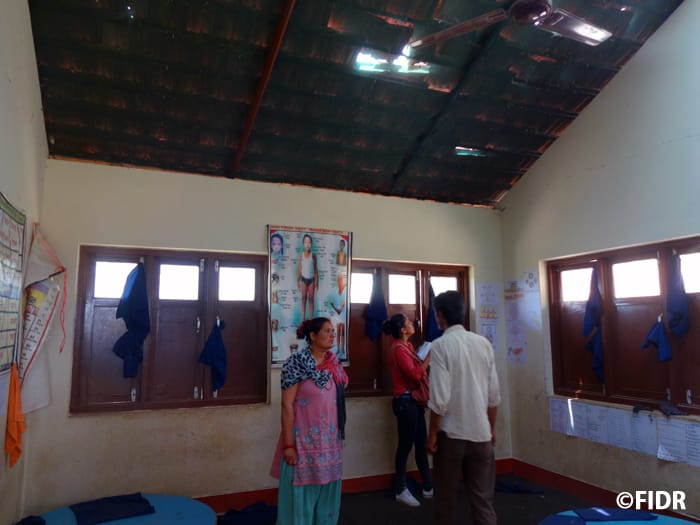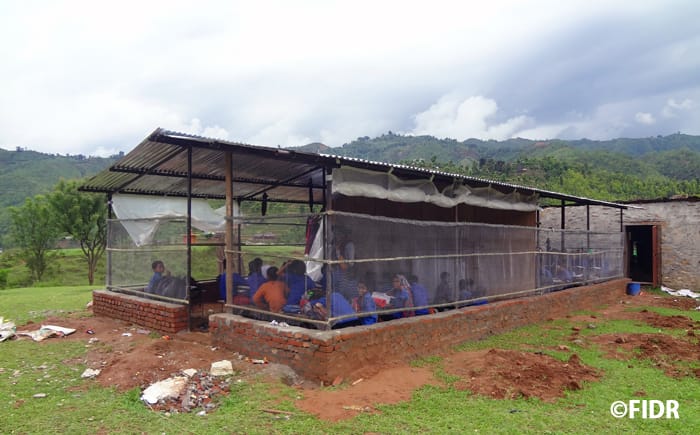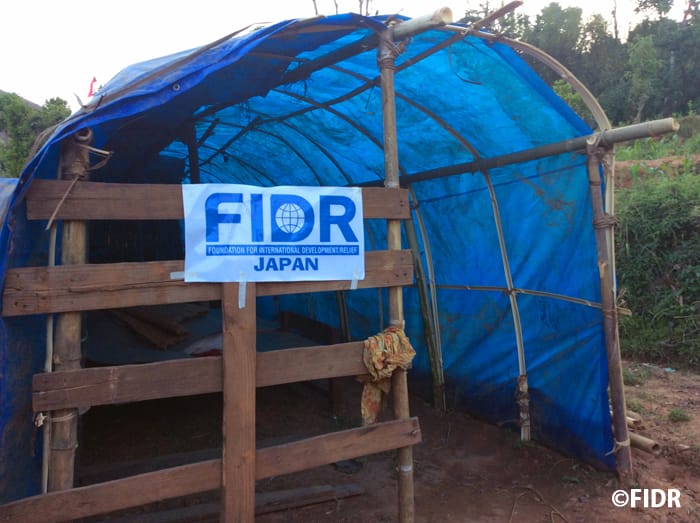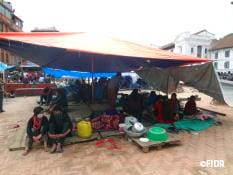[Nepal] Nepal Earthquake 2015
On 25 April 2015, a mega quake of magnitude 7.8 attacked central Nepal, followed by numerous after shakes: the huge one mag.7.3 on 12 May. The disaster was especially severe in Nepal’s mountainous areas, where assessment of the damages and emergency aid were deterred by the steep terrain and humble infrastructure. Allegedly the number of victims was as many as 8,857 and the damaged houses totalled 887,822 (as of 10 August, UNOCHA). Since right after the occurrence of the disaster, we have been engaged in emergency operation with a special focus on four VDCs in Dhading District---the target area of the FIDR’s community development project started in 2011. Making the best use of the accumulated lessons from the emergency responses FIDR has experienced in various places so far, we strive to deliver swift assistance adequately responding to the needs of the people in the devastated villages.
Damages in Dhading District
(as of 3 June, District government)
| FIDR project area (four villages) | Dhading District(47 villages) | |
| Deaths | 102 | 732 |
| Totally/Partially Collapsed Houses | 23,077 | 62,461 |
Operation Schedule

We conducted rapid assessment on damages and needs in Dhading district soon after the disaster. Having concluded that the affected people were in dire need of food and place to live in, we began the emergency operations to support the residents in the four VDCs in early May. At the same time we have planned to finish providing emergency supplies for interim survival in a month, and thereafter to support their earliest recovery of livelihood by their own resources. Because the local residents earn their livings by farming and cattle husbandry, delay in recovering their business will lead them to falling into further poverty. We also have planned to assist restoration of school facilities in the district since most of the schools suffered severe damages and students have been deprived of their chances to lean. In succession to delivery of emergency supplies, we contribute to setting up temporary learning centers (impromptu classrooms) and constructing school buildings in cooperation with the residents and local authorities.
Phase I(Emergency Response)
Duration : April – August 2015
Target Area : 4 VDCs of Dhading District(Khalte, Kumpur, Sunaula Bazar, and Kalleri)
| List of Assistances | Size of Beneficiary | Schedule |
| Distribution of Food(Rice 30kg) | 2,600hhlds | 6 May |
| Distribution of Tarpaulins for Shelter | 1,800hhlds | 7 May |
| Distribution of Sanitary Kits | 6,000hhlds | 19-25 May |
| Establishing Temporary Learning Centers | 100rooms | May –August |
| Restoration of Radha Krishna Primary School | 6rooms | June – July |
Phase II(Rehabilitation)
Duration : September 2015 –
Target Area : 4 VDCs of Dhading District
| List of Assistances | Size of Beneficiary | Schedule |
| Reconstruction of School Buildings | ||
| Recovery of Local Livelihood(Implemented as Dhading District Community Development Project) | ||
| Assistance to Healthy Growth of Children(Implemented as Dhading District Community Development Project) |
Letter of Appreciation by the Nepalese government
In December 2021, FIDR received the Letter of appreciation from the National Reconstruction Authority*of Nepal for the contribution to the reconstruction and rehabilitation of Nepalese people after the earthquake.
After Nepal Earthquake 2015, FIDR conducted emergency support such as distributing food, waterproof sheets, sanitary items to the residents of Dhading district, which was severely damaged by the earthquake. Also, many schools collapsed, which made children not be able to attend class. Responding to the request from the local government, FIDR constructed temporary classrooms right after the earthquake, then reconstructed 5 schools which were accomplished in 2017.
Since 2018, FIDR started the construction of two schools in Ramechhap district, where the support to improve the school environment was slow. These activities not only brought safe and secure learning environments to the children but also contributed to the economic and social development of the community.
This was the second time we received the Letter of appreciation from the National Reconstruction Authority following 2017. It was a great pleasure for the staff of FIDR Nepal office that the effort of FIDR in the reconstruction and rehabilitation was recognized by the government of Nepal and Nepalese residents once again.
*National Reconstruction Authority was a government agency of Nepal that coordinated reconstruction following the April 2015 Nepal earthquake and its activities were coming to an end in December 2021.
6 Years after Nepal Earthquake 2015
6 years have passed since the earthquake occurred in Nepal on 25th April 2015. About 9,000 people lost their lives by the earthquake. Every year, many events were held to mourning the victims of the earthquake and raise awareness on disaster preparedness. However, due to the spread of the new coronavirus infection COVID-19, many events were conducted online or cancelled this year.
Over the last 6 years, the rehabilitation and construction of infrastructure have been progressing*.
One of the great achievements was the completion of the reconstruction of Dharahara tower, the highest tower in Kathmandu city, which was collapsed in the earthquake. The reconstruction work was completed after three years, and the inauguration ceremony was held on 24th April this year.
Left side picture: Dharahara tower in Kathmandu City, which was collapsed in the earthquake
Right side picture: Prime Minister of Nepal joined in the inauguration ceremony on 24th April 2021.
After providing emergency supplies to the victims right after the earthquake, FIDR continued in improving the learning environment of children in Dhading district and Ramechhap district which severely affected by the earthquake. By 2020, FIDR constructed 104 temporary classrooms, reconstructed and repaired 56 classrooms at 8 schools, and constructed toilet facilities at 7 schools. Children now can study in the safe, comfortable school building with no anxiety against the earthquake.
Left side picture: The temporary classroom which was built by the school and community after the earthquake (Shiva basic school of Ramechhap district)
Right side picture: The new school building was completed in 2019 at Shiva basic school.
We could accomplish these reconstruction works thanks to many corporations and individuals who provided emergency relief support as well as the donation in various place. We would like to express our deep appreciation for all of your support.
*According to National Reconstruction Authority (NRA), as of April 2021, more than 90% of the affected people have been in progress of rebuilding their houses by the government grant. As for the reconstruction of government buildings, 90% of the work has been completed. More than 80% of educational facilities have been completed and more than 50% of archaeological heritage as well as health facilities have been rebuilt during 6 years.
(Photo)Source :BBC News https://www.bbc.com/news/world-asia-56873438
Appreciation certification by Nepalese government
In December 27th, 2017, there was a memorial ceremony which cerebrated the establishment of the National Reconstruction Authority for two years. FIDR was invited to the ceremony as an organization which had contribution on the reconstruction and rehabilitation of the areas which suffered from the earthquake in 2015.
In that ceremony, FIDR was one of 18 among 180 non-government organizations which were awarded by Mr. Sher Bahadur Deuba - Prime Minister as an organization that completed the reconstruction quickly and effectively after the earthquake. During the reconstruction process, despite many of difficulties and hard condition, we had never given up the work, therefore, this was our proud that our achievements and efforts were awarded by Nepalese government.
FIDR conducted the emergency supports such as providing food (rice), waterproof sheets, sanitary items as well as constructing the temporary learning centers in Dhading district which is the target area of the community development project. After conducting emergency response activity, FIDR quickly received the construction permit from the government before other organizations, then we started the reconstruction of 5 schools in 3 areas of Dhading district. The reconstruction working was accomplished in June 2017.
Mr. Mahendra, Secretary of Prime Minister office expressed his acknowledgement to the awarded organizations that “I am sincerely appreciated for your effort in the reconstruction and rehabilitation of Nepalese people after the earthquake, together with Nepalese government”.
Gun staff receiving a letter of appreciation (left) and thank you letter (right)
Reconstruction of five schools in Nepal has completed
Students and FIDR’s staffs were happy on the completion ceremony of Baghbachalla school reconstruction.
On June 28th, 2017, the completion ceremony of school reconstruction was hold at Baghbachalla high school in Kumpur area, Dhading district. Many people, including central governors, local councils and local residents participated in the ceremony. With the accomplishment of Baghbachalla school, all of school reconstruction projects that FIDR has supported at four areas of Dhading district since June 2016 has totally completed.
During the speech at the ceremony, local representative said that “This school reconstruction has a very important meaning with our village”, “From now on, we will cooperate together for the development after the rehabilitation”. He also expressed the appreciation towards the support of Japanese donors for school reconstruction. The students expressed their gratitude as well by singing and dancing with a song written by themselves.
As there are many people who met the difficulty in both geographical and social situation in this district, schools play an important role for the sustainably economic and social development of the community. Therefore, the permanent reconstruction of schools was a strong desire not only of the children but of community’s residents as well.
In Nepal, many organizations have been supporting for the school reconstruction in Nepal, however, due to some problems regarding to materials and workers, the construction work has not been on schedule. Facing with the same difficulty with other organizations, but FIDR took the lead in the completion of reconstruction work because we have a good relationship with local people and local authority throughout our long term regional development project. During the time of construction, we had many difficulties in transporting building materials and managing construction work in a severe mountainous region, however, we could finally accomplish construction work by the cooperation of our staffs and local people.
We hope this new school building will not only increase the children’s enthusiasm on leaning, but also contribute on the economic and social development of Dhading district.
Many people came to the ceremony and celebrated for the completion of Baghbachalla school reconstruction.
Baghbachalla high school was built on the mountain ridge
A completion ceremony of Nepal school construction
Children and local residents were happy with the completed school building (Newarpani elementary school)
FIDR was the first organization that got the permission of school building construction from the Reconstruction Department of Nepal, which was newly established in December 2015. The construction at 5 schools, including 3 primary schools, 1 secondary school and 1 high school in 4 areas of Dhading district began from June 2016. However, until April 2017, construction work at 2 primary schools completed and a completion ceremony as well as handover ceremony were held at each school on April 26th and 27th. Despite being worried about the rain because the rainy season will come soon in Nepal, the ceremonies were held under a blue sunny sky, with the participation of many people from Ministry of Education of Nepal and regional administrative officials. Mr. Zenji Kaminaga, board member of FIDR who was former Ambassador to Nepal also participated in the ceremony as well as Mr. Nobuhiko Egawa, Managing Director of FIDR.
Mr. Asta Rama from Ministry of Education said in the ceremony: "FIDR has accomplished the work that our country and other international donor organizations could not do". Mr. Asta Rama highly evaluated for the construction work which FIDR has done together with the local people and showed his excitement because these are the first schools that were reconstructed after the disaster.
People in the area also said that: "It is wonderful to receive such support from abroad, especially for the future of our children, when the support to the community and the rehabilitation are out of the reach of the government".
The children were so excited at the new school building.
The construction of three remaining schools will be completed soon.
Completion of school construction is upcoming!
In Annapurna primary schooler, the roofing work has completed and now, entered in the finishing work.
Two years have passed since the occurrence of Nepal earthquake on 25th April.
Firstly, FIDR carried out emergency relief activities in Dhading District. After that, we moved to the stage of reconstruction and implemented the construction of five elementary schools which were greatly damaged from the earthquake in order to improve the learning environment of children.
The construction project began in June 2016, but because of various reasons, it took nearly a year to finish the construction.
Five elementary schools are located in Dhading District which is located at the foot of the mountain where we can reach through the mountain path by one to two hours. Especially during the rainy season, landslides often occur on the way, and moving by car becomes more difficult.
In addition, the construction of school building this time used reinforced concrete structure which was never applied in the local before. It was difficult to gather construction workers with high technique level at the construction areas. Therefore, we had to invite engineers from Kathmandu to provide technical guidance to workers on construction sites in order to implement the conduction based on the design.
The collaboration of local people and FIDR’s local staffs has made them overcome many difficulties to complete the construction. We are trying to finish the work and set up equipment in the classrooms. In 5 school buildings, the construction of Annapurna Primary School and Newarpany Primary School will finish soon and a completion ceremony will be held at the end of April. We will report about this ceremony later.
People in Dhading District were highly conscious of their children's education, and therefore, the school reconstruction was highly expected. Due to this project, FIDR and people in the community are really looking forward to the day when the children can study in a more comfortable learning environment than before the disaster.
Nepal school construction ~ The no-road way to school - the way to monitor the construction project ~
Nepal is in the middle of rainy season, from June to September. It is said that rainy season may end in the late of September, however, rainy days still do not end.
Meanwhile, monitoring was carried out in school construction sites in Dhading District. We planned to reconstruct buildings of five schools in Dhading District, and three of them are under construction now.
It usually takes about 4 to 5 hours from Kathmandu where there is representative office of FIDR to the school construction sites by car. However, the road to the construction sites is muddy in the rainy season and there are mostly undeveloped roads that cannot be passed by vehicles, so, it takes more time to go to the sites in rainy season.
Last time, as we saw a bit of sunshine, we tried to go to the sites by car with a faint expectation that "Maybe the vehicle can pass", but unfortunately, we could not. One staff of FIDR, together with constructing consultant, went up the mountain and looked for a short-cut road (animal path), then headed to the construction sites.
We really appreciated to our local staffs as well as local people who are engaged in the construction every day. Because without the cooperation of everyone, school construction will not proceed at all.
We can see a strong will of local people who will not lose by the heavy rain.
We hope the rain season will pass soon and the construction work can start again.
Energetic voice of children from the temporary school building - one year after the Nepal big earthquake
A year has passed since the Nepal big earthquake on 25th April 2016.
Although there are still many areas where the first step of reconstruction has just started, children are beginning to recover their energy little by little.
By the end of last year, FIDR has constructed around 100 classrooms in 48 temporary school buildings and provided the learning environment to over 3,000 children in four areas of Dhading district where we have been carrying out emergency relief activities. In some schools, we also renovated the temporary school buildings to prevent from cold and rain, so that they can be used for a long time. Due to this construction, children are able to study in a stable learning environment.
Now we are preparing for the construction of five permanent primary schools that are the most damaged schools in the district. We have been trying to obtain the permission from related organizations such as Ministry of Education in Nepal, Social Welfare Committee where the building construction is approved, as well as Education Department of Dhading district, etc.
Children are really looking forward to the completion of the main school building construction. We will steadily push our activities one by one as quickly as possible to put the recovery on track.
The starting of school construction - one step towards full-scale reconstruction
A discussion at Sunkanya Lower Secondary School in Sunaula Bazar area where the school building is planned to be constructed.
One year has been passed since the Nepal earthquake occurred in April last year. Until now, FIDR has made effort to create a better educational environment through the construction of temporary classrooms and reconstruction of school buildings. In the upcoming time, we will implement the construction of some primary schools due to the necessity of the rehabilitation assistance.
We planned to construct five primary schools in Dhading District.
All of the elementary schools are located in the area that takes one to two hours to reach from the center of Dhading and through the narrow mountain path. There are sometimes landslides along the way, and during the rainy season in August, moving by car in this road becomes extremely difficult.
The old school buildings are made of thick stone wall without rebar reinforcing; so, it looks solid in the appearance. However, because the structure of the buildings was not to be against with the earthquake, many building collapsed even in Dhading district.
In the school buildings constructed by FIDR this time, we plan to use reinforcing bars to all the pillars and beams; and make the size of one building smaller than before so that it will be difficult to collapse. We also consider the ventilation and lighting properties when implementing the construction.
On February 8, we held a discussion with about 20 teachers and resident representatives at Gaurishankar Primary School, one of five schools being constructed. This school is located in the area where there are many households at the base of caste, therefore, it was not included in the support program of local government as well as international donor agencies. FIDR is planning to construct six classrooms in this school for 96 children.
Mrs. Binda, one of the residents' representatives, particularly paid attention to this construction work. She said, “Though my three children already graduated from elementary school, villagers have to build school for the children”.
"Because the school is a place that makes children “open their eyes”. I myself was not allowed to attend school when I was a child (note: because of caste discrimination), so I feel more about the importance of going to the school”.
The earthquake usually hit people who are in geographically and socially harsh conditions. FIDR does not plan the construction of school buildings for the purpose of simply recovering from the disasters but rather with the intention of creating a structure that will enhance the economic and social status of the community to the continuous development.
Construction starts from March and is expected to be completed sequentially from around July.
Radha Krishna Primary School Construction
As rehabilitation assistance activities, FIDR is conducting a project on creating a better educational environment for children in the affected areas after Nepal Big Earthquake.
Radha Krishna primary school in Kavre District, locating on the east side of the capital Kathmandu is a school constructed by FIDR in 2011. An earthquake in April caused the collapse of a number of private houses as well as public facilities in the same district, but in Radha Krishna primary school, because of applying some countermeasures to the earthquake at the time of construction, only a few damages was seen on some parts of the walls and rooves.
After confirming the condition of the school buildings and damage situation with construction engineers in May, we decided to restore some walls and rooves of the buildings.
The restoration work started in early June and completed in about a month. By changing the roof material that was commonly used before to a sheet using carbon fiber, not only the danger of collapse was greatly reduced but also the interior of the classroom became brighter and the ventilation was improved.
On July 18th, children, guardians, teachers, local government officials of Radha Krishna primary school together with FIDR gathered to see the completion of the school reconstruction. Local people said that "FIDR has never forgotten Radha Krishna primary school. They took a very quick response while the government and other organizations cannot do like that".
We will continue to rebuild the schools in Dhading District, where has been provided emergency assistance before.
In the older school building, a net was used to prevent the fall of the roof tile, but this time, we used a lightweight carbon fiber board for the reconstruction, so the net became unnecessary.
Temporary Learning Centers Are Established One After Another
We have been implementing emergency response in four VDCs in Dhading district, where 80% of school buildings out of 68 primary and junior high schools were damaged by the earthquakes. We started making 46 temporary learning centers in late May and have completed 41 so far. Students and teachers are glad to use the new TLCs with sufficient strength and comfort.
We had to overcome several difficulties in setting up the TLCs. First, although the general design of the TLCs was provided by the ministry of education, we had to deliberate the specifications of the building---it must be good enough in air ventilation, natural lighting, and sturdiness. We also placed a high value on the suitability of the design and specifications as compared to the construction technology of local residents because TLCs would be in use over a long period and the maintenance for them should be carried out by the locals.
So we took a hint from a structural object the local residents are all familiar with---henhouse. It fills all the requirements above. Local residents can built them without difficulty using locally available materials such as galvanized plates, steel pipes, bamboo, etc.
Next, it was hard to find the sites for TLCs. Since most of the schools in our target area are located on the ridges of mountains, flat spaces were scarcely left on the premises of the collapsed schools.
And, rainy season; heavy rain has been pouring in Dhading since June. It is truly tough work to carry construction materials through mountain trails. Yet, we keep working to complete the rest of planned TLCs as early as we can.
Setting Up Temporary Learning Centers in Progress
We have been implementing emergency response for the residents in the disaster-stricken district.
As the quakes knocked down many schools, we have been establishing 46 buildings of temporary learning centers (TLCs) in Dhading district since late May.
Teachers said, “After the earthquake, children are afraid of staying in a dark room.” So, we decided to use wire screen for a large part of the walls to take in natural lighting and fresh air. When it rains or strong wind blows, the opening parts of the walls will be covered with plastic sheets.
We have completed procuring all the necessary materials for TLCs by end of June, and carried to the respective schools. Presently we are working with local residents to establish TLCs and have completed eleven buildings as of 5 July.
Hand It to Every Person
For past a month, we have realized the delivery of food, tarpaulins for shelters and sanitary items in the target area of Dhading district. Every time the leaders of villages requested us to promise one thing before we started distribution.
“Please make sure to hand in the supplies one person by one person.”
As this was what FIDR considered important, we promptly answered, “So will we do.” Hearing that, all the leaders looked relieved. It is the fact that in many places emergency supplies have failed to reach to the families because various agencies to implement delivery tend to just “carry” them to the destinations, not to “distribute” to each family entitled to receive.
The size of the beneficiary in one place totals hundreds ---occasionally over a thousand --- households; accordingly, it is quite big labour for us to hand in one by one. The local residents look nervous waiting in a long line probably because they had few experiences like this. But when we greet them saying “Namaste!” in a merry voice as handing in the supplies, they show relaxed faces and the distance between them and FIDR staff instantly gets diminished.
No matter whether you are at the side to provide the supplies or to receive them, all of us share the experience of the massive disaster. Looking at faces each other and handing in the items with greeting words, we have a common feeling to go forward step by step to reconstruction. We have learned that the field to distribute supplies are also the field of “indispensable communication.”
Distributed Hygiene Kits to 6,000 Households
From May 21st to 25th 2015, we distributed hygiene kits (soap, detergent, ointment, oral rehydration salt, and disinfection agent) to 6,000 households, almost all of the households in the four VDCs in Dhading district.
These days in Dhading, diarrhea and infection have been prevalent among the residents. In addition, it is concerned that because the full-scale rainy season is coming in early June, sanitary conditions may get worse, and more and more people will suffer infection. The residents were greatly happy that we have completed the distribution of hygiene kits before the rainy season come.
As FIDR continued to gather information about the existing state in Dhading district, it appeared that local residents need temporary school building. Therefore, we are going to discuss with the Department of Education in Dhading to build 50 temporary learning centers.
Ready for Distributing Sanitary Kits
Sharing information that we have gathered, we repeatedly hold discussion to make plans for the next operation
On 15 May, we have almost finished the procurement of sanitary kits to deliver in Dhading.
The next step was to hold discussion with the local leaders so that the provided items would be handed to thousands of households in isolated villages in mountains without fail. As we explained them about the importance of cooperation by the communities, they confirmed us to actively participate at site.
While some villages receive relief supplies from many aid organizations, some villages receive nothing. People can get no information that they do want to know, and feel bewildered to encounter inconsistent information. The media reports their complaints about their current conditions have been increasing over the disaster-hit areas.
Because they underwent severe damages in their minds by the disaster, it is important not to incur additional fear or confusion. We think it is our obligation to set up our operation quickly and carefully so that we can distribute the relief goods to them as early as possible. We plan to start distribution in the villages in middle of this week.
Reservoir Turned to Shelter
The people who lost their houses by the earthquake cannot help living outside; however, those in the villages in Dhading district at altitude over 1,000m have received little assistance for a while.
In such a situation, the residents in some village proposed, “Shall we utilize tarpaulin of reservoir for farm water to establish a shelter?” Others said, “But is it okay to lose water we have saved for our farming?” After discussion, they reached to an agreement. “It is true that water for agriculture is important, but now we have to think reconstruct our lives first.” They began to collaborate to build shelter right away.
One sheet of tarp is large enough for making shelter to accommodate about ten people. The shelter is dubbed “FIDR Cottage” by the local residents because FIDR assisted them to construct reservoirs since 2011 for resourcing water to make farming possible during dry season. Almost all of the residents in the village worked in cooperation to excavate a swimming-pool-size hole in mountain and covered it with tarpaulins. As of October 2014, the number of reservoirs reached as many as 49 in the target areas of the project.
When we looked at their shelter covered with used tarps, we felt really glad that our support was effectively diverted by the local residents’ initiative.
Preparing for Rainy Season, FIDR Distributes Roofing Material
It is reported that even two weeks after the quake, some parts of the disaster-hit areas have received no assistance. We have already delivered tarpaulin for 1,200 households in Dhading district, mountain region of central Nepal. In parallel, we are preparing for providing sanitary items such as soap, antiseptic, etc., to 6,000 households.
The local residents began to recover their lives by establishing tentative shelters using tarpaulins supplied by FIDR and materials available nearby. Yet, it will take quite long time to reconstruct houses.
Because full-fledged rainy season here starts in early June and harvesting season of corn begins in July, they need space for storing harvests keeping dry. We keep working in the local field to find out what the people really want and to provide necessary materials before monsoon onset.
FIDR Starts to Deliver Tarpaulins for 2,400 Households
It has been five days since the big earthquake and people in local communities seem to be much more fatigued. The media reports the deceased counts over 6,000 and the number of victims has been increasing day by day.
Presently the FIDR team in Nepal consists of three staff: Country Representative with Japanese nationality and two Nepalese. When the earthquake happened, we had been attending a ceremony at a school in Dharding disctrict, in which we have been working since 2011. Fortunately, no children or the staff were injured, and the FIDR team quickly returned to Kathmandu to prepare for engaging in emergency assistance by gathering information and communicating with relevant organizations for disaster response.
Due to proximity to the epicentre, Dhading district suffered massive damages; more than 75% of the houses in the district were totally collapsed or severely destroyed. As rainy season is coming closer, the weather is likely to be wet and temperature at night gets pretty low.
We have recognized that the local residents urgently need shelters to weather out rain and wind; therefore, we have decided to deliver tarpaulins to approximately 2,400 households in the district. We will carry out the delivery at site either on 4th or 5th May. Our team members are going to enter Dhading next week to realize smooth and effective support for the residents.
Activity Report
Under Construction
DONATION
Your generous donation now will have impacts
on children and communities in our fields.







